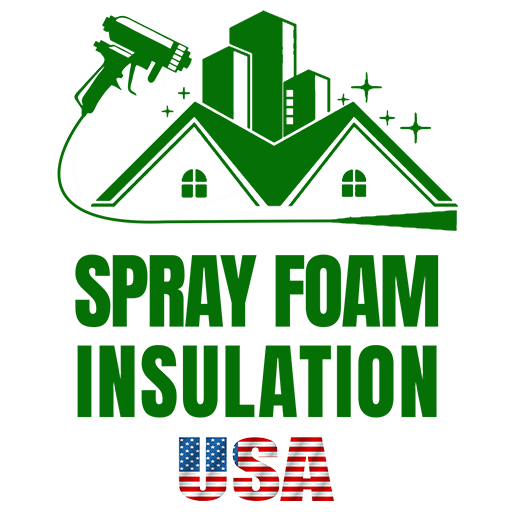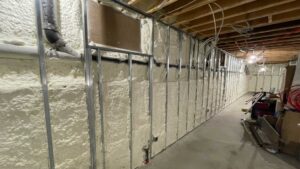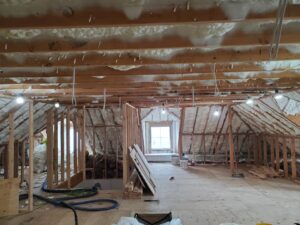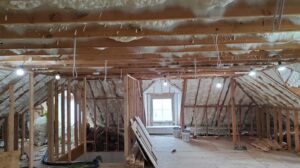Airtight Insulation Solutions: Quick Overview
- Airtightness: Essential for energy efficiency and indoor comfort.
- Importance: Reduces energy bills and increases the lifespan of HVAC systems.
- Benefits: Improves indoor air quality, prevents moisture buildup, and enhances overall home value.
Airtight insulation is a game-changer for homeowners and business owners in NY and NJ looking to slash energy bills, boost comfort, and support environmental sustainability. By tightly sealing the nooks and crannies where air can escape, airtight insulation keeps your home cozy in the winter and cool in the summer. Plus, it acts as a barrier against dampness, allergens, and pollutants. This means not just a more comfortable living space but a healthier one too.
Beyond comfort and health, tightening up your building’s envelope can have a positive impact on your wallet. Less air leakage means less strain on your heating and cooling systems, translating to lower energy consumption and substantial savings over time. Moreover, investing in quality airtight insulation like spray foam can increase your property’s market appeal and value.
But what makes insulation airtight, and why is it so crucial for your building’s performance? Let’s dig into the essence of airtight insulation solutions, highlighting their importance and the undeniable benefits they bring to the table.

Understanding Airtight Insulation
When it comes to keeping your home cozy and your energy bills low, airtight insulation solutions are a game-changer. Let’s break down what you need to know about the different types available, focusing on spray foam, foam board, and expanding foam.
Types of Airtight Insulation
Spray Foam Insulation is like a superhero for your home. It’s a liquid that turns into foam, expanding to fill cracks and gaps. This creates a seal that keeps warm air in during winter and out during summer. It’s great for both new homes and adding to existing ones. Plus, it can help reduce noise from outside.
Foam Board Insulation is a rigid panel of insulation. You can put it on walls, roofs, and floors. It’s good at stopping heat from escaping or entering your home. It’s like putting a warm jacket around your house.
Expanding Foam is used for smaller jobs, like sealing openings around windows and doors. It expands to fill the space it’s sprayed into, blocking air leaks.
Why These Matter
Each type of insulation plays a vital role in making your home more energy-efficient. Here’s why they’re important:
-
Spray Foam creates an airtight seal that can significantly lower your energy bills. It’s like putting a stopper in a bottle – it keeps the inside temperature constant by preventing air from leaking out or in.
-
Foam Board provides strong insulation with less thickness required than other types. It’s like having a thin, super-warm blanket that works really well to keep you cozy.
-
Expanding Foam is perfect for those hard-to-reach places that other types of insulation might miss. It ensures no nook or cranny is left uninsulated.
Benefits
-
Energy Efficiency: All these types of insulation help your home stay warmer in winter and cooler in summer without overworking your heating or cooling systems. This means lower energy bills and a smaller carbon footprint.
-
Comfort: A well-insulated home is a comfortable home. These insulation solutions help maintain a consistent temperature, making your living space more enjoyable.
-
Noise Reduction: Spray foam, in particular, can help reduce the noise from outside, making your home quieter and more peaceful.
-
Moisture Control: By creating an airtight seal, these insulation types can also help prevent moisture problems, which can lead to mold and mildew.
Choosing the Right Type
The best type of insulation for your home depends on several factors, including your climate, home design, and budget. Here’s a quick guide:
-
Spray Foam is best for creating a complete air seal, even in irregular spaces.
-
Foam Board is ideal for covering large, flat areas like walls or under roofs.
-
Expanding Foam is your go-to for sealing gaps and cracks around windows, doors, and other openings.
Understanding these options can help you make an informed decision about how to make your home more energy-efficient and comfortable. A little upfront investment in insulation can lead to big savings on your energy bills in the long run.
For those considering enhancing their home’s insulation, it’s always a good idea to consult with a professional to determine the best solution for your specific needs. Spray Foam Insulation USA can provide expert advice and installation services to ensure your home is as energy-efficient as possible.
In the next section, we’ll dive into the science behind airtight insulation, explaining how it works to keep your home comfortable and energy-efficient.
The Science of Airtight Insulation
When we talk about making our homes more comfortable and energy-efficient, understanding the science behind airtight insulation is key. Let’s break it down into simple concepts: Thermal Bridging, Air Leakage, and Building Airtightness.
Thermal Bridging
Imagine your home wrapped in a cozy blanket. Now, picture a zipper slightly open. That zipper is like a thermal bridge – a weak spot where heat can escape. In buildings, thermal bridges are parts of the structure that allow heat to pass through more easily than through the insulated surrounding areas. These can be metal frames, concrete, or wood. By using airtight insulation solutions, we can ‘zip up’ these spots, keeping the warmth inside and the cold outside.
Air Leakage
Air leakage is like leaving a window cracked open all winter long. It’s the unwanted guest at the party, bringing in cold air and letting out the warm. In technical terms, it’s the uncontrolled flow of air in and out of the building through gaps and cracks. This not only makes your heating or cooling system work harder but can also lead to moisture problems, which nobody wants. Airtight insulation acts as a barrier, stopping this flow and keeping the inside temperature just right.
Building Airtightness
Building airtightness is all about control. It’s ensuring that every breath of air that enters and leaves your home does so on your terms. This means less energy spent on heating and cooling, which is good for your wallet and the planet. Airtight buildings also reduce the risk of mold and increase overall comfort by eliminating drafts.
Airtight insulation solutions, like spray foam, create a seamless barrier over the entire building envelope. This not only covers the nooks and crannies but also addresses those pesky thermal bridges and air leakage points. The result? A home that’s snug, secure, and efficient.
By understanding these key scientific principles, we can see how vital airtight insulation is to creating a comfortable and efficient home. With the right products and installation techniques, we can tackle thermal bridging, air leakage, and achieve superior building airtightness. This is the foundation of what Spray Foam Insulation USA offers – a comprehensive approach to making your home the best it can be, from the inside out.
In the next section, we’ll explore the key products for achieving this level of airtight insulation. Whether you’re building new or upgrading your existing home, knowing your options will help you make the best choice for your comfort and energy efficiency.
Key Products for Airtight Insulation
When it comes to creating a home that’s snug as a bug, there are a few superhero products you should know about. These are the champions of the airtight insulation world: FM330 Pro Air Seal, Polyurethane Spray Foam, and Rigid Foam. Let’s dive into what makes each of these options stand out.
FM330 Pro Air Seal
Imagine a knight in shining armor for your home. That’s FM330 Pro Air Seal. It’s not just any sealant; it’s a high-performance adhesive that plays a critical role in making homes airtight. It seals gaps and cracks, keeping the unwanted air out and the comfy air in. Easy to apply and incredibly durable, it’s a top pick for professionals aiming for top-notch airtightness.
Polyurethane Spray Foam
Next up, we have Polyurethane Spray Foam. Picture this: a foam that expands to fill every nook and cranny, creating an impenetrable barrier against air leakage. It’s like magic in a can! This foam is a powerhouse for insulation, offering both high R-value (which means it’s really good at stopping heat flow) and excellent air sealing properties. Whether it’s in the attic, walls, or floors, spray foam wraps your home in a cozy blanket that keeps energy costs down and comfort up.
Rigid Foam
Last but certainly not least is Rigid Foam. Think of it as the sturdy shield for your castle. Rigid foam insulation comes in sheets that you can cut to fit and then attach to walls, roofs, and floors. It’s fantastic for adding extra insulation to your home without taking up much space. Plus, it’s tough against moisture, making it a great choice for damp areas like basements.
Why These Products Rock:
- FM330 Pro Air Seal is like the ultimate gap-filler, ensuring tiny invaders of cold air don’t stand a chance.
- Polyurethane Spray Foam is the all-rounder, providing both airtightness and top-tier insulation.
- Rigid Foam is the reliable sidekick, offering solid protection against both heat loss and moisture.
Incorporating these products into your home’s insulation plan can significantly enhance its efficiency and comfort. Achieving airtight insulation isn’t just about slapping on some material here and there. It’s about choosing the right products and applying them with care and precision.
We’ll dive into how to install these products and the best practices to ensure your home is as energy-efficient and comfortable as possible. Stay tuned for a world where chilly drafts are a thing of the past, and cozy, efficient living spaces are the norm.
Installation and Best Practices
When it comes to airtight insulation solutions, how you install them is just as important as what you install. Let’s break down the essentials: Continuous Layer, Proper Sealing Techniques, and Adhesive Selection.
Continuous Layer
Imagine wrapping your home in a snug blanket. That’s what a continuous layer of insulation does. It means no gaps, no missed spots. Just like when you zip up your coat on a windy day, every inch matters.
- Why It’s Key: A continuous layer stops heat from sneaking out or cold air from creeping in. It’s the cornerstone of making your home airtight.
- How to Do It: Start by inspecting the area. Make sure surfaces are clean and ready. When applying products like spray foam, ensure it’s evenly spread, reaching all nooks and crannies.
Proper Sealing Techniques
Sealing is like the art of closing every door and window during a storm. You want to make sure nothing gets through. This goes for every joint, seam, and penetration in your home.
- Why It Matters: Even the smallest gap can be a big problem. Proper sealing techniques ensure that the barrier against air and moisture is complete.
- Best Practices: Use sealants and tapes designed for the job. For areas that are tricky to seal, like where different materials meet, be extra diligent. Apply sealants smoothly, ensuring full coverage without gaps.
Adhesive Selection
Choosing the right adhesive is like picking the right glue for a critical school project. You need something strong, reliable, and suitable for the materials you’re working with.
- Why the Right Choice is Crucial: The wrong adhesive can mean failure over time. Conditions like temperature changes and humidity can weaken the wrong product.
- Tips for Selection: Look for adhesives specifically designed for insulation materials. Consider the conditions they’ll face, like moisture or extreme temperatures. When in doubt, consult with a professional or the product manufacturer.
Remember, the goal of airtight insulation solutions is not just to save on energy bills (though that’s a big plus). It’s about creating a comfortable, durable living space. With the right continuous layer, sealing techniques, and adhesives, you’re on your way to a home that stands strong against the elements.
As we wrap up this section, keep in mind that these steps are crucial for ensuring your home’s insulation is effective and lasting. Next, we’ll tackle some common questions about airtight insulation to clear up any uncertainties you might have. Stay tuned for insights that could help enhance your home’s efficiency even further.
Common Questions on Airtight Insulation
When it comes to making your home more energy-efficient, airtight insulation solutions are a game changer. Let’s dive into some common questions to help you understand how different insulation types can make your home snug and save you money on energy bills.
Is spray foam insulation air tight?
Yes, it is. Spray foam insulation is like a superhero for your home. It doesn’t just sit there; it expands, filling up cracks and gaps, making sure no air sneaks in or out. It’s like wrapping your house in a cozy, airtight blanket. This means your heating and cooling systems don’t have to work overtime, saving you money and making your home more comfortable.
Can expanding foam create an airtight seal?
Absolutely. Expanding foam is like magic in a can. When you spray it into openings around your house, it grows to fill the space, creating a solid barrier. This barrier keeps unwanted air out, making sure your home stays the temperature you want it to be. It’s a quick and effective way to patch up those pesky leaks that let in drafts or let out your cozy warm air.
How does foam board contribute to airtight insulation?
Foam board is like the unsung hero of insulation. It’s rigid, but it’s also lightweight and easy to cut to fit any space. When installed correctly, with all the joints sealed, foam board acts as a continuous layer of insulation. This means it helps stop air from leaking in or out of your home. It’s particularly good for basements and attics, where you want to keep the outside air out and your heated or cooled air in.
In wrapping up this section, airtight insulation solutions, like spray foam, expanding foam, and foam board, are key to making your home more energy-efficient. They seal up the nooks and crannies, keeping your home comfortable and your energy bills lower. Next, we’ll explore how to enhance your home’s efficiency with these airtight insulation solutions. Stay tuned for practical tips on air sealing attics, using reflective bubble insulation, and the benefits of radiant barriers.
Enhancing Home Efficiency with Airtight Insulation
Making your home more energy-efficient is not just about adding insulation; it’s about choosing the right type and ensuring it’s installed correctly. Let’s dive into how air sealing attics, using reflective bubble insulation, and incorporating radiant barriers can significantly enhance your home’s efficiency.
Air Sealing Attics
The attic is often the primary source of air leaks in a home. Warm air rises and escapes through tiny gaps, leading to higher energy bills and an uncomfortable living environment. Air sealing is the first step towards an airtight attic. It involves:
- Identifying Leaks: Common leak spots include attic hatches, light fixtures, and plumbing vents.
- Choosing the Right Sealant: For larger gaps, expanding foam is effective, while caulk works well for smaller cracks.
- Professional Assessment: Consider a professional energy audit to pinpoint all the air leak sources accurately.
By sealing these leaks, you not only improve insulation but also prevent moisture issues that can lead to mold and structural damage.
Reflective Bubble Insulation
Reflective bubble insulation works by reflecting radiant heat, keeping your home warmer in the winter and cooler in the summer. It’s a lightweight, easy-to-install solution, especially effective in attics and walls. Here’s why it’s a smart choice:
- Energy Efficiency: It reflects up to 97% of radiant heat, significantly reducing energy costs.
- Ease of Installation: Flexible and easy to cut, it can fit around any obstacle, making it ideal for tricky spaces.
- Moisture Barrier: It acts as an additional barrier against moisture, which is particularly beneficial in damp climates.
Radiant Barriers
Similar to reflective bubble insulation, radiant barriers are designed to reflect heat rather than absorb it. Installed in the attic, they can reduce cooling costs by up to 10% in warm climates. Key benefits include:
- Heat Reflection: By reflecting the sun’s radiant heat, these barriers keep attics cooler, which helps lower cooling costs.
- Compatibility: They can be used alongside other insulation types to enhance overall efficiency.
- Longevity: Radiant barriers are durable and require little to no maintenance.
Putting It All Together
Enhancing your home’s efficiency with airtight insulation solutions is a smart investment. Start with air sealing the attic to tackle the most significant source of energy loss. Then, consider adding reflective bubble insulation and radiant barriers for their heat-reflecting properties and additional benefits like moisture control.
The goal is not just to insulate but to create a comprehensive system that addresses air leakage, heat transfer, and moisture management. With the right approach, you can enjoy a more comfortable home and lower energy bills year-round.
Spray Foam Insulation USA continues to lead in providing innovative airtight insulation solutions that meet the evolving needs of homeowners. Stay tuned for more tips and insights on making your home as energy-efficient as possible.
Conclusion
In wrapping up our exploration of airtight insulation solutions, it’s clear that the path to a more energy-efficient, comfortable home involves thoughtful consideration of the insulation methods we choose. At Spray Foam Insulation USA, our commitment to excellence and innovation stands at the forefront of our mission. We are dedicated to helping you achieve an optimal living environment through the use of advanced insulation technologies.
Spray Foam Insulation USA is not just a service provider; we are your partners in transforming your home into a bastion of comfort and efficiency. Our expertise in spray foam and other airtight insulation solutions empowers homeowners to make informed decisions that not only enhance the livability of their spaces but also contribute significantly to environmental conservation.
Here’s why choosing us for your insulation needs is a smart move:
-
Expertise and Experience: With years of experience under our belt, we understand the intricacies of airtight insulation like no other. Our team is equipped with the knowledge and tools to address your specific needs, ensuring that every nook and cranny of your home is properly insulated.
-
Customized Solutions: We recognize that every home is unique. That’s why we offer personalized assessments to identify the most effective insulation strategy for your space. Whether it’s spray foam, foam board, or another method, we tailor our approach to suit your requirements.
-
Sustainability at Heart: Our commitment to eco-friendly practices means that choosing Spray Foam Insulation USA is a step towards reducing your carbon footprint. By enhancing the energy efficiency of your home, you’re not only saving on energy costs but also contributing to a healthier planet.
-
Customer Satisfaction: Your comfort and satisfaction are our top priorities. From the initial assessment to the completion of the project, we ensure a seamless and hassle-free experience. Our positive customer reviews and testimonials are a testament to our dedication to excellence.
In conclusion, airtight insulation is a crucial component of a modern, energy-efficient home. By choosing Spray Foam Insulation USA, you’re opting for quality, reliability, and environmental responsibility. Let us help you make your home a model of efficiency and comfort.
Ready to transform your home with airtight insulation solutions? Discover the advantages of partnering with Spray Foam Insulation USA.
Together, let’s create a more comfortable, energy-efficient, and sustainable living environment.





